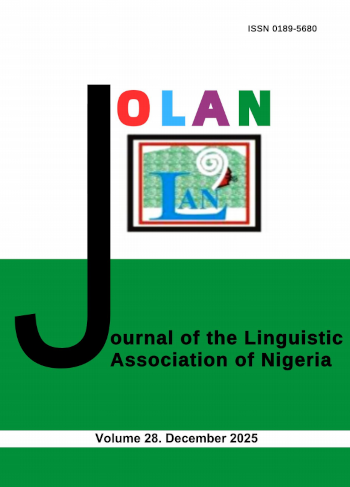Disambiguating Ambiguous Constructions in Ngwà Ìgbò
Keywords:
Ngwà, Construction, Disambiguation, Structure, Lexeme, AmbiguityAbstract
This paper examines ambiguity in Ngwà dialect of Ìgbò, spoken in South-eastern Nigeria. Ambiguity is a situation whereby a single lexical item or phrase in a construction is construed to have more than one meaning. The aim is to identify and analyse lexical and
structural elements in the dialect which lend a construction to multiple interpretations with a view to disambiguating them. Data were elicited through questionnaires and interviews from six competent Ngwà native speakers who were within the age range of 45-60 years. The participants cut across different groups: community and religious leaders, titled persons, as well as male and female politicians. Simple descriptive method of analysis was adopted using Leipzig Glossing Convention and inter-linear glossing. The article examines lexical items in Ngwà verbal communication that are ambiguous. The result shows that context and word order, among other factors, in most cases are responsible for the construction of ambiguity. For adequate resolution, it is suggested that the meaning of a construction be sought outside the context. The study is useful to language teachers, students and curriculum designers as it greatly enhances how language is most effectively taught and learnt.
References
Akinola, S. (2016). Ambiguity in Kolokuma.M.A Thesis. University of Port Harcourt.
Akmajian, A., Demers, R., Farmer, A. & Harnish, R. M. (2008). Linguistics: An introduction to language and communication. New Delhi: Prentice Hall of
India Private Ltd.
Crystal, D. (1998). A dictionary of linguistics and phonetics. Retrievedfrom http://onlinelibrary.wiley.com 23/02/2022
Dayal, V. (2004). The universal force of free choice any linguistic variation yearbook 4:15 – 40. Retrieved from http//www.ingentaconnect.com 10/03/2022
Ejele, P. (1996). An introductory course on language. Port Harcourt: University of Port Harcourt Press.
Emenanjo, E. (1978). Elements of modern Ìgbò grammar. Ibadan: Oxford University Press.
Fromkin, V., Rodman, R. & Hyams, N. (2007). An introduction to language. Boston: Lachina Publishing Services.
Lehrer, A. (1985). Markedness and anatonymy.Journal of Linguistics, 21(2):397 – 429.
Lyons, J. (1977). Semantics. Cambridge: Cambridge University Press.
Maciver, A. (2004). The new first aid in English. Oxford Advanced Learners Dictionary. London: Hooder Gibson.
Mbah, B. (2008). Ambiguity in Ìgbò: In Ikenga International Journal of Institute of African Studies, 10 (1/2), 1 – 20.
Ndimele, O-M. (1999). A first course on morphology and syntax. Port Harcourt: Emhai Printing and Publishing Co.
Ndimele, O-M. (2007). Semantics and the Frontiers of Communication. Port Harcourt: University of Port Harcourt Press Ltd.
Omego, C. (2013). Linguistic semantics. Port Harcourt: Harey Publishing Company.
Onah, J. (2011). Ambiguity and polysemy in Ìgbò: A case study of Nsukka dialect cluster. MA Thesis, University of Nigeria Nsukka.
Pryser, E. (1984). English without tears. Glasgow: William Collins Sons & Co.
Ullman, S. (1962). Semantics: An introduction to science of meaning. New York: Barnes and Noble.














